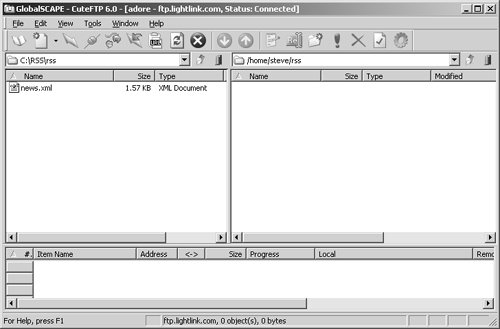Uploading Your RSS Feed
| Now that you've created your new feed, you can make it available to the rest of the world. Start by uploading your RSS feed's XML file to a Web server. Tip Some sites specialize in hosting RSS feeds and give you online tools to create those feeds. For example, Global Syndication (www.globalsyndication.com/rss-hosting) offers a service that starts at $3.95 per month or $39.95 per year as of this writing. There are other sites that even let you host for free, such as IceRocket. There are as many ways to upload XML files as there are to upload HTML files to Web servers. The two most common ways of uploading files are using FTP and HTML interfaces. Tip When you upload XML files to a Web server, you may have to set a protection level so that the files can be accessed but not modified by others. For example, if your Web server is Unix-based, you could set the protection level to 644, which lets you read and write the file, and allows others only to read them. To determine if you need to set the protection level of your RSS files, check with your Web server's technical team. Using an FTP InterfaceYou may already have an FTP application, and if not, it's easy to find one. Take a look at the software-distribution site www.tucows.com, for example, which lists more than 100 FTP programs (just search for FTP). Most of these applications are shareware or freeware. FTP applications have been getting easier and easier to use. One of the most popular programs is CuteFTP. To upload files using CuteFTP, just drag the file from the window on the left, which shows files on your computer, to the window on the right, which shows files on your Web server (Figure 3.33). Figure 3.33. CuteFTP is an easy-to-use file transfer application. When you upload an RSS XML file, store it in the appropriate directory on your Web server, just as you would an HTML file. Your XML file must be accessible using a URL for users to read it, just as they would need a URL to read an HTML file. Besides using a dedicated FTP application to upload RSS files, you can let your RSS editor do this for you. After all, you created your RSS feeds in your RSS editorwhat could be more convenient than letting it upload and install your feed on the server? That's particularly useful when you want to use previous items as a template, and make the modifications you need to create new items from the old ones. Most people who frequently edit and change their RSS feeds use a dedicated desktop or laptop RSS editor that lets them not only create new items, but also look at and modify old ones. And to upload, it's just a click of a button. As you've seen, both NewzAlert Composer and FeedForAll RSS let you create, edit, and upload feeds easily. But desktop RSS editors usually cost somewhere in the $20 to $40 range. Tip There's only one RSS editor that will upload your RSS feeds and is free: RSS Publisher from Extra Laboratories, which you can find at www.extralabs.net/products.htm. If you're interested, better snap it up quick, because it looks like the company might be phasing it outExtra Laboratories now has a similar for-pay product, and RSS Publisher is no longer listed on its Web site's home page. Using an HTML InterfaceAnother way to upload RSS XML files is to use an HTML interface. These are Web pages that you navigate to and let you upload files. There are no generic HTML uploadersthey're all ISP-specific. Your ISP must have one set up before you can use it. HTML uploaders are set up by ISPs to let their users upload HTML files easily, but they can also upload XML files for you. |